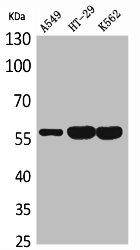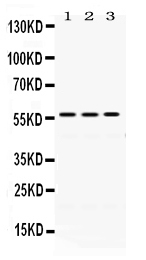Erp57 (Grp58) Antibody (OASE00105)
OASE00105
ApplicationsImmunoFluorescence, ImmunoPrecipitation, Western Blot, ImmunoCytoChemistry, ImmunoHistoChemistry
Product group Antibodies
TargetPDIA3
Overview
- SupplierAviva Systems Biology
- Product NameErp57 (Grp58) Antibody (OASE00105)
- Delivery Days Customer23
- ApplicationsImmunoFluorescence, ImmunoPrecipitation, Western Blot, ImmunoCytoChemistry, ImmunoHistoChemistry
- CertificationResearch Use Only
- ClonalityMonoclonal
- Clone IDMap.ERp57
- Concentration1 mg/ml
- ConjugateUnconjugated
- Gene ID2923
- Target namePDIA3
- Target descriptionprotein disulfide isomerase family A member 3
- Target synonymsER60, ERp57, ERp60, ERp61, GRP57, GRP58, HEL-S-269, HEL-S-93n, HsT17083, P58, PI-PLC, protein disulfide-isomerase A3, 58 kDa glucose-regulated protein, 58 kDa microsomal protein, ER protein 57, ER protein 60, disulfide isomerase ER-60, endoplasmic reticulum P58, endoplasmic reticulum resident protein 57, endoplasmic reticulum resident protein 60, epididymis secretory protein Li 269, epididymis secretory sperm binding protein Li 93n, glucose regulated protein, 58kDa, phospholipase C-alpha, protein disulfide isomerase-associated 3
- HostMouse
- IsotypeIgG1
- Scientific DescriptionERp57, also known as Glucose Regulated Protein 58 (Grp58), Hormone-Induced Protein-70 (HIP-70) and microsomal Carnitine Palmitoyltransferase, is a member of the protein disulfide isomerase family, containing two canonical CXHC tetrapeptide active site motifs (1-5). It has quite a few diverse roles. It functions as an accessory oxidoreductase involved in disulfide bond formation. In the ER, ERp57 interacts with membrane bound calnexin and soluble calreticulin (lectin chaperones) via their praline rich P-domain arms. Lectin chaperones bind nascent non-native glycoproteins, and position ERp57 to act upon the immature or misfolded glycoproteins that possess mono-glycosylated side chains. ERp57 deletion impairs posttranslational phases of influenza hema-glutinin folding, and causes accelerated release of MHC-I molecules, resulting in the coupling of sub-optimal peptides and reduced expression and stability on the cell surface (6). ERp57 also contains two thioredoxin active-site sequences, CGHC and an estrogen-binding domain. ERp57 is induced by both estrogen and leuteinizing-hormone-releasing hormone in the hippocampus (7).
- Storage Instruction-20°C
- UNSPSC12352203






